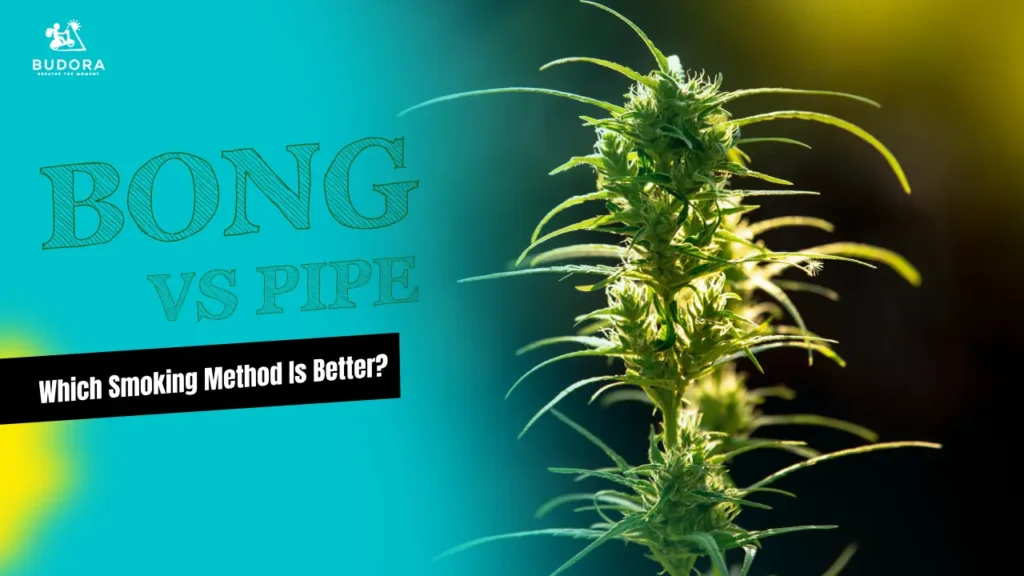Can I Workout After Smoking Weed? Risks, Benefits & Expert Insights
- Budora Team
- No Comments
- Cannabis WeedBlogs


The intersection of cannabis use and fitness has garnered significant attention in recent years. With the increasing legalization and de-stigmatization of marijuana, many fitness enthusiasts are exploring the question: Can I work out after smoking weed? This article delves into the scientific research, expert opinions, and real-life experiences to provide a comprehensive answer.
Key Highlights
- Cannabis before workouts may boost motivation and enjoyment, especially for low-intensity exercises like yoga and walking.
- THC can impair coordination and increase heart rate, making high-intensity or complex workouts riskier.
- CBD and cannabis may aid in post-workout pain relief, sleep quality, and muscle recovery.
- Experts suggest starting with low doses and avoiding heavy lifts or unfamiliar routines while high.
Understanding Cannabis and Its Components
Cannabis contains various compounds, with THC (tetrahydrocannabinol) and CBD (cannabidiol) being the most prominent. THC is psychoactive, leading to the “high” sensation, while CBD is non-psychoactive and is often associated with therapeutic benefits. These compounds interact with the body’s endocannabinoid system, influencing mood, pain perception, and other physiological processes. That’s why many people explore cannabis before exercise for pain management or focus. For those interested in exploring different cannabis strains for a comprehensive overview.
Potential Benefits of Working Out After Smoking Weed
Enhanced Enjoyment and Motivation
A study from the University of Colorado Boulder found that cannabis users who consumed marijuana before exercise reported increased enjoyment and motivation during workouts. Participants noted that cannabis made activities like running and weightlifting more pleasurable, potentially encouraging longer and more frequent exercise sessions. This might explain why some gymgoers prefer smoking weed before gym sessions to increase motivation.
Pain Management and Recovery
Cannabis has been recognized for its analgesic properties. Some athletes use it to manage pain and inflammation post-workout, aiding in recovery. CBD, in particular, has been studied for its potential to reduce soreness and improve sleep quality, both crucial for effective recovery. For more insights into the therapeutic uses of cannabis, you might find the medical use of cannabinoids article informative.
Risks and Considerations
Impaired Coordination and Reaction Time
THC can affect motor skills, leading to decreased coordination and slower reaction times. This impairment can increase the risk of injuries, especially during high-intensity workouts or exercises requiring precise movements.
Cardiovascular Effects
Cannabis consumption can lead to an increased heart rate and changes in blood pressure. For individuals engaging in cardio training, it’s important to note the effects of weed on cardio and how it could interfere with stamina or breathing.
Legal and Ethical Implications
While cannabis is legal in many regions, it’s essential to consider the legal status in your area and any regulations set by sports organizations. For instance, athletes like Sha’Carri Richardson faced suspensions due to positive cannabis tests, highlighting the importance of understanding the rules governing substance use in competitive sports.
Best Types of Workouts When High
While the effects of cannabis vary from person to person, certain types of workouts are generally safer and more enjoyable after using marijuana. If you’re exploring the idea of working out after smoking weed, here are some fitness routines that pair better with a mild cannabis buzz, especially for beginners.
Low-Intensity Cardio
Activities like walking, light jogging, or cycling at a steady pace are great options. They don’t require complex coordination or high-impact movements, making them safer if your balance or reflexes are slightly affected. Many users find that weed and endurance workouts, such as long walks or hikes, feel more immersive and calming. For those interested in exploring energizing strains, the best weed strains for energy guide provides valuable information.
Yoga and Stretching
Yoga is a favorite among cannabis users due to its slow pace and focus on breathing. Combined with cannabis, it enhances body awareness and relaxation. Many find that it deepens their mind-body connection and helps in active recovery.
Bodyweight Exercises
Calisthenics like push-ups, squats, and lunges are relatively safe when under the influence. If you’re planning to hit the gym after getting high, these simple movements help you stay active without putting you at high risk of injury from heavy equipment or complex form requirements. For convenience, pre-rolls and blunts offer ready-to-use options.
Dance or Flow Workouts
Free movement activities like dance, flow mobility, or even light aerobic workouts can feel more engaging and creative. Music and rhythm often feel enhanced, making these workouts more enjoyable for some users.
Workouts to Avoid
If you’re high, it’s better to avoid:
- Heavy compound lifts (e.g., squats, deadlifts)
- High-Intensity Interval Training (HIIT)
- Contact sports or martial arts
- Any skill-based routine requiring sharp focus
Pro Tip: Stick to familiar routines. Never attempt a new, high-risk workout for the first time under the influence.
Expert Opinions and Research Findings
Research on the effects of cannabis on exercise performance is still evolving. A systematic review published in the Journal of Cannabis Research concluded that chronic cannabis consumption had no significant impact on athletic performance metrics like VO2Max and physical work capacity. However, acute use might lead to increased heart rate and potential performance decrements. This brings up the broader question of THC and physical performance in both amateur and professional settings.
Another study highlighted that while cannabis might enhance the enjoyment of exercise, it doesn’t necessarily improve performance and could make workouts feel more strenuous. When it comes to weed and endurance, some users report improved focus during low-intensity, longer sessions, but scientific support remains limited.
Best Practices for Those Considering Cannabis Before Workouts
- Start with Low Doses: If you’re new to combining cannabis with exercise, begin with minimal amounts to assess your body’s response.
- Choose the Right Strain: Opt for strains known for their uplifting and energizing effects, and be cautious with high-THC strains that might induce sedation.
- Avoid Complex Movements: Engage in exercises that don’t require intricate coordination, especially during initial experiences.
- Stay Hydrated: Cannabis can lead to dehydration, so ensure adequate fluid intake before, during, and after workouts.
- Listen to Your Body: Pay attention to how you feel. If you experience dizziness, shortness of breath, or any discomfort, stop exercising and rest.
- Be Cautious with Strength Training: If you’re into marijuana and strength training, be aware of how THC may alter your form, focus, or muscle control, especially when lifting heavy.
Conclusion
The question, “Can I work out after smoking weed?” doesn’t have a one-size-fits-all answer. While some individuals find that cannabis enhances their workout experience by increasing enjoyment and reducing pain, others might face challenges like impaired coordination and increased cardiovascular strain.
It’s crucial to consider personal health, fitness goals, and legal implications before integrating cannabis into your fitness routine. For some, hitting the gym after getting high might be an energizing experience, while for others, it could compromise safety and performance. As research continues to evolve, staying informed and making educated decisions will ensure both safety and effectiveness in your workouts, starting with using regulated, high-quality cannabis from services like weed delivery Vancouver.
FAQS About Workout After Smoking Weed
How long should you wait to workout after smoking weed?
It’s generally advisable to wait 1–2 hours after smoking weed before working out. This gives your body time to stabilize, as cannabis can initially raise your heart rate and lower blood pressure, which may increase the risk of dizziness or discomfort during intense exercise. Always listen to your body and start slow if you’re trying this for the first time.
Does weed affect testosterone levels?
Research on this topic is mixed. Some studies suggest marijuana use may lower testosterone levels, especially with chronic use. However, newer research, such as a study from Denmark, found higher testosterone concentrations in some cannabis users. These differences may depend on usage frequency, dosage, and individual physiology.
Does weed affect your workout and gains?
Yes — both positively and negatively. Some users say cannabis enhances workout enjoyment, focus, and mind-muscle connection. Others report decreased motivation or reduced energy, which can hinder performance. Its impact on muscle growth and strength training isn’t fully conclusive but could vary depending on how your body reacts to THC.
Why does weed make me feel more motivated to workout?
THC — the primary psychoactive compound in cannabis — interacts with the endocannabinoid system, a network in your brain that regulates mood, motivation, and reward. For some individuals, this can boost mental drive and workout enjoyment, especially during lower-intensity activities.
How can I stay healthy if I smoke weed regularly?
While smoking anything carries risks, there are ways to maintain a healthy lifestyle alongside cannabis use:
- Eat a nutrient-rich diet with fresh fruits and vegetables
- Engage in regular physical activity
- Stay hydrated and get enough sleep
- Schedule regular health checkups and screenings
- Consider alternatives to smoking, like edibles or vapes, which may be less harsh on the lungs
Being mindful of your habits can help balance your wellness and cannabis lifestyle.
Like this article?

Budora Team
OTHER ARTICLES YOU MAY LIKE




